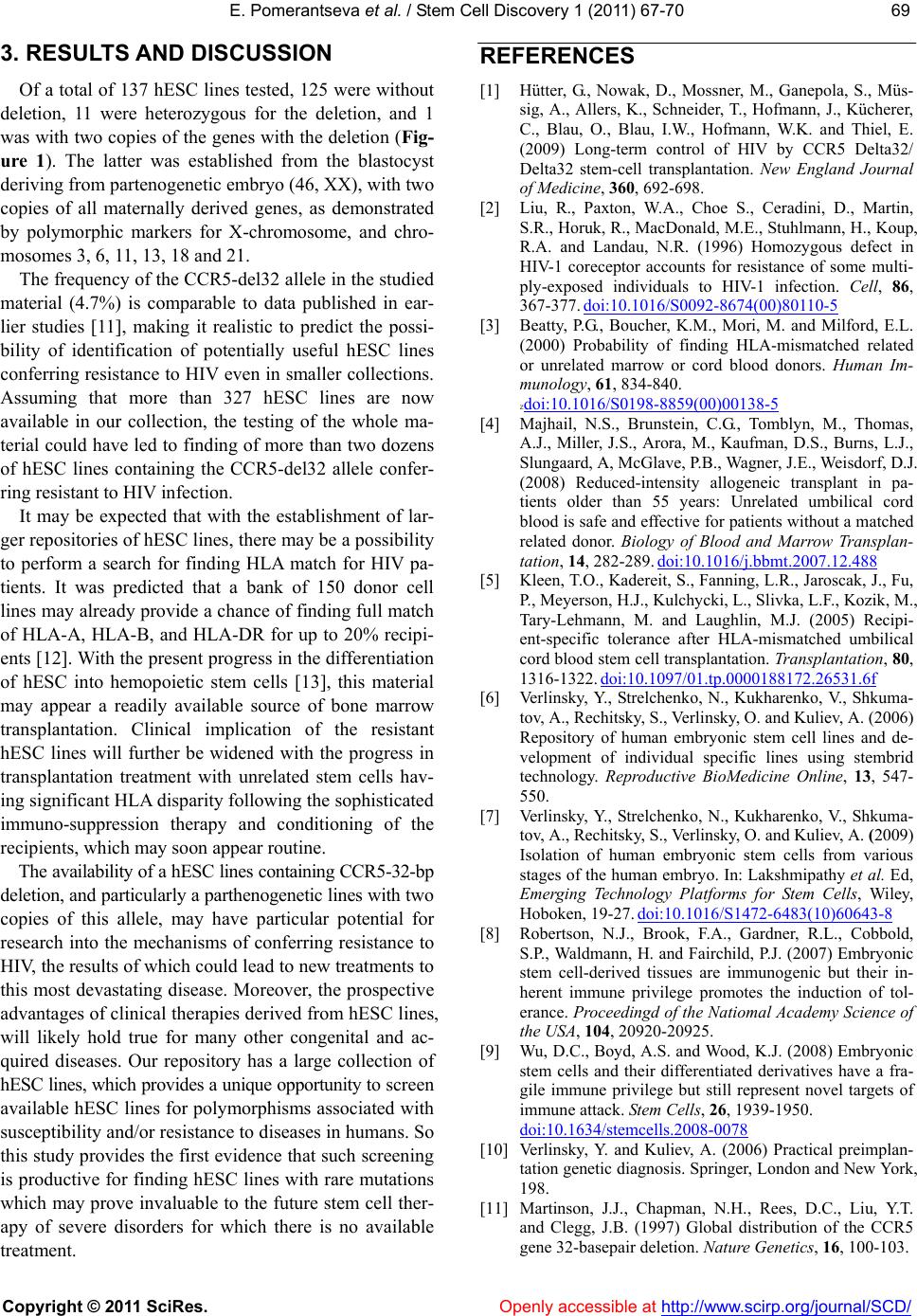
E. Pomerantseva et al. / Stem Cell Discovery 1 (2011) 67-7 0
Copyright © 2011 SciRes. Openl y accessible at http://www.scirp.org/journal/SCD/
6969
3. RESULTS AND DIS CUS SION
Of a total of 137 hESC lines tested, 125 were without
deletion, 11 were heterozygous for the deletion, and 1
was with two copies of the genes with the deletio n (Fig-
ure 1). The latter was established from the blastocyst
deriving from partenogenetic embryo (46, XX), with two
copies of all maternally derived genes, as demonstrated
by polymorphic markers for X-chromosome, and chro-
mosomes 3, 6, 11, 13, 18 and 21.
The frequency of the CCR5-del32 allele in th e studied
material (4.7%) is comparable to data published in ear-
lier studies [11], making it realistic to predict the possi-
bility of identification of potentially useful hESC lines
conferring resistance to HIV even in smaller collections.
Assuming that more than 327 hESC lines are now
available in our collection, the testing of the whole ma-
terial could have led to finding of more than two dozens
of hESC lines containing the CCR5-del32 allele confer-
ring resistant to HIV infection.
It may be expected that with the establishment of lar-
ger repositories of hESC lines, th ere may be a possibility
to perform a search for finding HLA match for HIV pa-
tients. It was predicted that a bank of 150 donor cell
lines may already provide a chance of finding full match
of HLA-A, HLA-B, and HLA-DR for up to 20% recip i-
ents [12]. With the present progress in the differentiation
of hESC into hemopoietic stem cells [13], this material
may appear a readily available source of bone marrow
transplantation. Clinical implication of the resistant
hESC lines will further be widened with the progress in
transplantation treatment with unrelated stem cells hav-
ing significant HLA disparity following th e soph isticated
immuno-suppression therapy and conditioning of the
recipients, which may soon appear routine.
The availability of a hESC lines containing CCR5-32-bp
deletion, and particularly a parthenogenetic lines with tw o
copies of this allele, may have particular potential for
research into the mechanisms of conferring resistance to
HIV, the results of which could lead to new treatments to
this most devastating disease. Moreover, the prospective
advantages of clinical therapies derived from hESC lines,
will likely hold true for many other congenital and ac-
quired diseases. Our repository has a large collection of
hESC lines, which provides a unique opportunity to sc r e en
available hESC lines for po lymorphisms associated with
susceptibility an d/or resistance to d iseases in hu mans. So
this study provides th e first evidence that such screening
is productive fo r finding hESC lines with rare mutations
which may prove invaluable to the future stem cell ther-
apy of severe disorders for which there is no available
treatment.
REFERENCES
[1] Hütter, G., Nowak, D., Mossner, M., Ganepola, S., Müs-
sig, A., Allers, K., Schneider, T., Hofmann, J., Kücherer,
C., Blau, O., Blau, I.W., Hofmann, W.K. and Thiel, E.
(2009) Long-term control of HIV by CCR5 Delta32/
Delta32 stem-cell transplantation. New England Journal
of Medici ne, 360, 692-698.
[2] Liu, R., Paxton, W.A., Choe S., Ceradini, D., Martin,
S.R., Horuk, R., MacDonald, M.E., Stuhlmann, H., Koup,
R.A. and Landau, N.R. (1996) Homozygous defect in
HIV-1 coreceptor accounts for resistance of some multi-
ply-exposed individuals to HIV-1 infection. Cell, 86,
367-377. doi:10.1016/S0092-8674(00)80110-5
[3] Beatty, P.G., Boucher, K.M., Mori, M. and Milford, E.L.
(2000) Probability of finding HLA-mismatched related
or unrelated marrow or cord blood donors. Human Im-
munology, 61, 834-840.
zdoi:10.1016/S0198-8859(00)00138-5
[4] Majhail, N.S., Brunstein, C.G., Tomblyn, M., Thomas,
A.J., Miller, J.S., Arora, M., Kaufman, D.S., Burns, L.J.,
Slungaard, A, McGlave, P.B., Wagner, J.E., Weisdorf, D.J.
(2008) Reduced-intensity allogeneic transplant in pa-
tients older than 55 years: Unrelated umbilical cord
blood is safe and effective for patients without a matched
related donor. Biology of Blood and Marrow Transplan-
tation, 14, 282-289. doi:10.1016/j.bbmt.2007.12.488
[5] Kleen, T.O., Kadereit, S., Fanning, L. R., Jaroscak, J., Fu,
P., Meyerson, H.J., Kulchycki, L., Slivka, L.F., Kozik, M.,
Tary-Lehmann, M. and Laughlin, M.J. (2005) Recipi-
ent-specific tolerance after HLA-mismatched umbilical
cord blood stem cell transplantation. Transplantation, 80,
1316-1322. doi:10.1097/01.tp.0000188172.26531.6f
[6] Verlinsky, Y., Strelchenko, N., Kukharenko, V., Shkuma-
tov, A., Rechitsky, S., Verlinsky, O. and Kuliev, A. (2006)
Repository of human embryonic stem cell lines and de-
velopment of individual specific lines using stembrid
technology. Reproductive BioMedicine Online, 13, 547-
550.
[7] Verlinsky, Y., Strelchenko, N., Kukharenko, V., Shkuma-
tov, A., Rechitsky, S., Verlinsky, O. and Kuliev, A. (2009)
Isolation of human embryonic stem cells from various
stages of the human embryo. In: Lakshmipathy et al. Ed,
Emerging Technology Platforms for Stem Cells, Wiley,
Hoboken, 19-27. doi:10.1016/S1472-6483(10)60643-8
[8] Robertson, N.J., Brook, F.A., Gardner, R.L., Cobbold,
S.P., Waldmann, H. and Fairchild, P.J. (2007) Embryonic
stem cell-derived tissues are immunogenic but their in-
herent immune privilege promotes the induction of tol-
erance. Proceedingd of the Natiomal Academy Science of
the USA, 104, 20920-20925.
[9] Wu, D.C., Boyd, A.S. and Wood, K.J. (2008) Embryonic
stem cells and their differentiated derivatives have a fra-
gile immune privilege but still represent novel targets of
immune attack. Stem Cells, 26, 1939-1950.
doi:10.1634/stemcells.2008-0078
[10] Verlinsky, Y. and Kuliev, A. (2006) Practical preimplan-
tation genetic diagnosis. Springer, London and New York,
198.
[11] Martinson, J.J., Chapman, N.H., Rees, D.C., Liu, Y.T.
and Clegg, J.B. (1997) Global distribution of the CCR5
gene 32-basepair deletion. Nature Genetics, 16, 100-103.